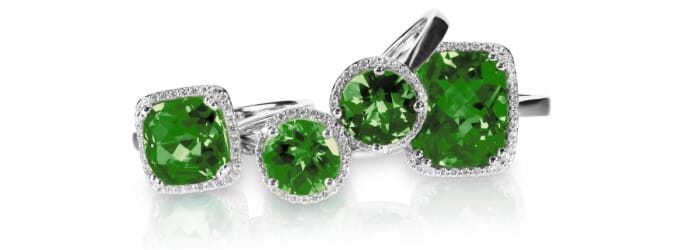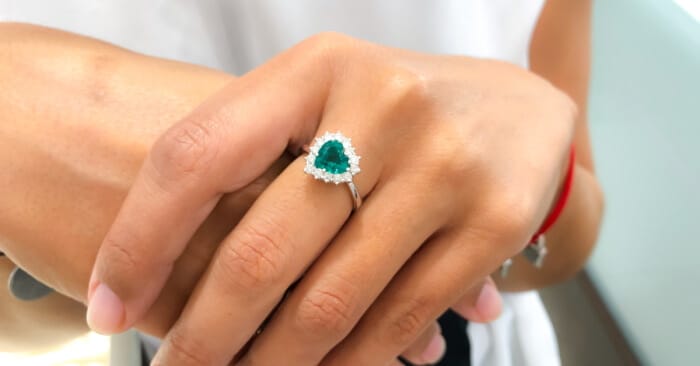Known for their mesmerizing green color, emeralds are one of the most adored gemstones. They bring forth feelings of opulence and mystique like no other green gemstone can.
The emerald is the most popular member of the beryl mineral family and the birthstone for the month of May. It’s one of the three traditional color (green, red, and blue) gems for emeralds, rubies, and sapphires respectively.
Emeralds have a different appeal than sapphires and rubies, as even high-quality emeralds have inclusions or imperfections – 99% of emeralds are treated to improve their clarity.
Read on to learn more about this fascinating gemstone, its history, and why emerald jewelry is so popular. If you are thinking about pawning, selling or buying emeralds or emerald jewelry, we trust you’ll find this beginner’s guide to emeralds useful and informative.

Emeralds are found all over the world, but many gem experts believe the best ones are from Columbia, followed by Zambia. For example, only in Colombia are the rare trapiche emeralds found that resemble the spokes of a wheel.
Colombia produces about 95% of the world’s emeralds.
A Short History of Emeralds
According to the Gemological Institute of America (GIA), the first known emerald mines were in Egypt, dating from at least 330 BC into the 1700s. Cleopatra was known to have a passion for emeralds and used it in her royal adornments.
Some of the most famous emeralds were looted by Spanish conquistadors in South America when they invaded the New World in the 16th century. It includes the Mogul Mughal Emerald, a 217.80ct carved emerald sold at Christie’s for $2.2 million in 2001. It now resides in the Museum of Islamic Art, Doha, Qatar.
When the Spanish invaded, the Incas had already been using emeralds in their jewelry and religious ceremonies for hundreds of years. It wasn’t long before the trade in emeralds caught the attention of European and Asian royalty. And the popularity of emeralds only increased over the centuries that followed.

Emeralds are often used in engagement rings as an alternative to a traditional diamond.
Legends and Folklore
Throughout history, there have been many legends and folklore about the mystical properties of emeralds. It includes:
- The ability to foresee the future when placing the gem under the tongue
- Have calming effects and helps reduce stress
- Protects the wearer against evil spells
- Reveals if a lover’s declaration of love is sincere and genuine
- Has rejuvenation properties
- Relieves eye, spine, and chest problems
The 4Cs of Emeralds
All gemstones are evaluated based on the 4Cs – color, clarity, cut, and carat (weight).
Color
An emerald gets its color from trace amounts of chromium, but vanadium can also play a role.
Color plays a critical role in emeralds and can be broken down into three components, namely Hue, Tone, and Saturation.
Hue – Emeralds, by definition, can only be green in color. Slight color variations, such as bluish green and yellowish green are acceptable. But, if it’s too yellow, it’s no longer an emerald but a green beryl instead.
Tone – An emerald must have a medium-light tone. If not, it’s classified as a green beryl.
Saturation – Refers to color purity.
Clarity
Emeralds nearly always have fracture-filled inclusions or imperfections. In addition, they typically have crystalline minerals inside them. And a combination of liquid, solid, and gas inclusions are common.
Cut
The cut of an emerald can, to some extent, determine its clarity. But gem cutters often don’t have much to work with, especially with stones that have a high number of inclusions.
Note: Colored gem cuts are seldom perfectly symmetrical. The cut is typically adjusted to maximize the weight of the gemstone.
Carat
Carat weight plays an important role in determining the price of an emerald. As a rule of thumb, all else being equal, the price doubles with every carat increase. For example, if a one-carat gem is worth $1,000, a two-carat one will be worth $2,000, and a three-carat one $4,000.
Note that although clarity and cut have an impact on the price as well, the primary factor that determines an emerald’s value is its color.

How to Clean Emeralds
The safest way to clean an emerald is gently scrubbing it in warm, soapy water.
Cleaning emeralds ultrasonically or with hot steam is risky as most emeralds are fracture-filled.
That's a Wrap
Emeralds have a special allure that sets them apart from diamonds and other colored gems, including green gemstones such as peridots and green sapphires.
We trust that after reading this beginner’s guide to emeralds, you’ll have a better understanding and appreciation of this mesmerizing gem.
If you have any questions or want to buy, sell, or pawn loose emeralds or emerald jewelry, don’t hesitate to contact Maxferd. We have in-house experts who are ready to assist you.
Call us at (800) 888-7296 or visit one of our pawn shops in Los Angeles or our San Francisco pawn shop to find out how we can help you.

